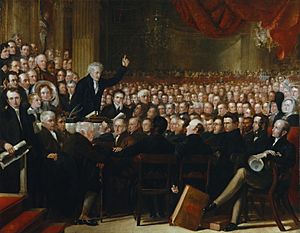Constantine Moorsom facts for kids
Quick facts for kids
Constantine Richard Moorsom
|
|
|---|---|

Moorsom at the 1840 Anti-Slavery Conference
|
|
| Born | 22 September 1792 High Stakesby, Whitby, North Riding of Yorkshire
|
| Died | 26 May 1861 (aged 68) Russell Square, London
|
| Resting place | Kensal Green Cemetery |
| Nationality | English |
| Occupation | Royal Navy Vice-Admiral |
| Known for | Innovation |
| Spouse(s) | Mary |
| Children | many |
| Parent(s) | Robert and Eleanor Moorsom |
| Relatives | William Moorsom |
Constantine Richard Moorsom (born September 22, 1792 – died May 26, 1861) was an important Vice-Admiral in the Royal Navy. He was known for his clever ideas and innovations.
Moorsom commanded HMS Fury. This was a special type of ship called a bomb vessel. It was used in the Bombardment of Algiers in 1816. This attack targeted Barbary pirates in Algiers.
Constantine was the son of Admiral Sir Robert Moorsom. His father was a famous naval officer who fought in the Battle of Trafalgar. Although Constantine was listed on his father's ship, HMS Revenge, during the Battle of Trafalgar, he was actually at school at the time. Later in his life, Moorsom also became the chairman of the London & North Western Railway.
Contents
Biography
Early Life and Education
Constantine Richard Moorsom was born on September 22, 1792. His father was Admiral Sir Robert Moorsom. His mother was Eleanor Scarth.
Constantine joined the Royal Navy College in Portsmouth. He was a very bright student. He won a top medal and three prizes for his skills in mathematics.
Moorsom's career in the Royal Navy was marked by his clever ideas. His younger brothers also joined the navy. One brother, William Scarth Moorsom, later became a successful railway engineer.
Constantine's first naval assignment was on HMS Revenge. This ship was off the coast of Portugal. It helped defend Cadiz. In 1816, he became a lieutenant. He then served on several ships. These included HMS Superb and HMS Warspite.
He later commanded HMS Goree and HMS Terror. Then he took command of the bomb vessel, HMS Fury.
The Bombardment of Algiers
In August 1816, Moorsom commanded HMS Fury during the Bombardment of Algiers. This was an attack on Barbary pirates. The goal was to stop them and free enslaved people.
During the battle, HMS Fury fired twice as many mortars as any other ship. This was because of a special fitting Moorsom had designed. His clever method was later adopted as a standard practice for other ships.
Further Promotions and Ideas
Moorsom became a post captain in 1818. His innovative thinking was noticed again in 1822. He was given command of HMS Ariadne. This ship had been difficult to handle. It had been changed from a frigate to a corvette.
Moorsom rearranged the ship's storage. This made Ariadne seaworthy again. He even sailed it around the Cape of Good Hope to prove his point. He briefly served as an acting Commodore in Mauritius. From 1825 to 1827, he was captain of HMS Prince Regent at Chatham Dockyard.
Even though he didn't take more sea missions, he continued to rise in rank. He became a rear-admiral. In 1843, he wrote an essay called Principles of Naval Tactics. He updated it three years later.
Fighting Against Slavery
In 1840, Moorsom attended the World Anti-Slavery Convention in London. This important meeting took place at the Freemasons Hall. Leading abolitionists from all over the world gathered there. These were people who wanted to end slavery.
A famous painting shows the convention. Moorsom can be seen in it. He is behind the head of Joseph Sturge. Sturge was a key figure in the Anti-Slavery International. This group organized the conference. The painting is now in the National Portrait Gallery.
Leading in Railways
Constantine Moorsom also became involved in the railway business. He worked for the same company where his brother, William, was an engineer.
In 1841, he was elected to the board of the Birmingham and Gloucester Railway. He quickly became its chairman. He stayed in this role until 1843. At that time, the company joined the Midland Railway.
He also served as a director for the London & Birmingham Railway from 1837 to 1839. In 1851, he was promoted to Rear-Admiral of the Blue. From 1852 until his death in 1861, he was the chairman of the London & North Western Railway. During this time, he also led a committee for the British Association. This committee studied how steamships performed.
Constantine Moorsom became a vice-admiral in 1857. He passed away on May 26, 1861, in Russell Square, London. He had many children with his wife, Mary Maude. One of their sons was the politician James Marshall Moorsom.


